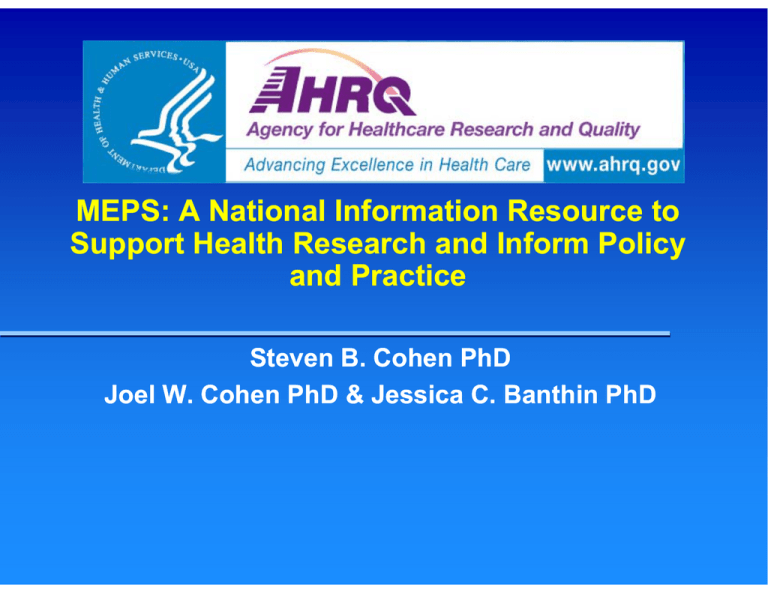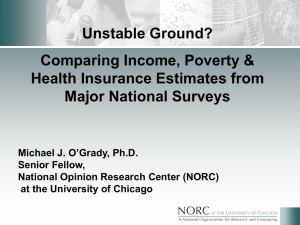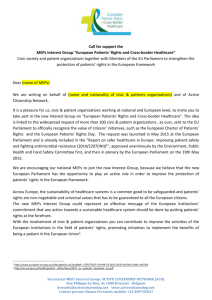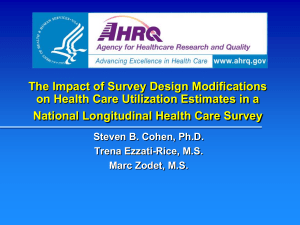MEPS: A National Information Resource to
advertisement

MEPS: A National Information Resource to Support Health Research and Inform Policy and Practice Steven B. Cohen PhD Joel W. Cohen PhD & Jessica C. Banthin PhD Presentation AHRQ mission MEPS overview Program outreach and impact Research Update Modeling and Simulation Studies MEPS Data Products and Dissemination AHRQ Mission Statement To improve the quality, safety, efficiency, and effectiveness of health care for all Americans. AHRQ A Activities ti iti Knowledge Creation – Creating data, research findings and tools Synthesis and Dissemination – Disseminating information to multiple stakeholders to improve the system Implementation – Partnering with stakeholders to implement proven strategies for health care p improvement Medical Expenditure Panel Survey (MEPS) Annual Survey of 14,000 households: provides national estimates of health care use, expenditures, di iinsurance coverage, sources of payment, access to care and health care quality Permits studies of: Distribution Di t ib ti off expenditures dit and d sources off payment Role of demographics, family structure, insurance Expenditures for specific conditions Trends over time MEPS Components Household Component (HC) Medical Provider Component (MPC) Insurance Component (IC) MEPS Household Component Sample Design Oversampling of policy relevant domains 1996 Minorities (Blacks & Hispanics) 1997 Minorities Low income Children with activity y limitations Adults with functional limitations Predicted high g expenditure p cases Elderly 1998--2001 1998 Minorities 2002--2008 2002 Minorities, Asians, Low Income 2009+ Minorities, Asians 14,000 households; ~32,000 persons HC - Purpose Estimates annual health care use and expenditures p Provides distributional estimates S Supports t person and d family f il llevell analysis Tracks changes in insurance coverage and a de employment p oy e t Longitudinal design; linkage to NHIS Key Features of MEPS MEPS--HC Survey of U.S. civilian noninstitutionalized population Sub Sub--sample of respondents to the National Health Interview I t i Survey S (NHIS) – Linkage to NHIS Oversample of minorities and other target groups Panel Survey – new panel introduced each year – Continuous data collection over 2 ½ year period – 5 inin-person interviews (CAPI) – Data D t from f 1st 1 t year off new panell combined bi d with ith data from 2nd year of previous panel MEPS Overlapping Panels (Panels 13 and 14) MEPS Household Component MEPS Panel 13 2008-2009 1/1/2008 NHIS 2007 Round 1 1/1/2009 Round 2 Round 3 NHIS 2008 Round 1 Round 4 Round 2 Round 5 Round 3 MEPS Panel 14 2009-2010 Round 4 Round 5 MEPS - Integrated Survey Design Features National Health Interview Survey serves as sample frame for Household Component C Linked survey of medical providers Linkages to secondary data sources Census Bureau Business Register serves as Insurance Component sample frame Evaluation of Accuracy of MEPS after Adjustments for Survey Nonresponse MEPS has overlapping panel design: 1st year of new panel combined with data from 2nd year of previous year’s panel to yield annual data Multiplicative response rates: product of NHIS RR and MEPS RR (multiplicative function of round specific RR: 3 rounds for new panel/5 rounds for old panel) Detailed adjustments for survey nonresponse: NHIS to MEPS round 1/MEPS round 1 to round 3: to derive annual estimates for year t MEPS round 3 to round 5: annual estimates for year t+1. Medical Provider C Component t Purpose Compensate for household item nonresponse Gold standard for expenditure estimates Greater accuracy and detail Imputation source Supports methodological studies Medical Provider C Component t Targeted Sample All associated hospitals and associated physicians Sample of associated office office--based physicians All associated home health agencies All associated pharmacies p Data Collected Dates of visit Diagnosis and procedure codes Charges Ch ((exceptt R Rx)) and d payments t Collection of Rx Data in MEPS ~8,000 pharmacies sampled annually – data on prescribed medicines purchased by h households h ld Data obtained: – Medication Name – National Drug Code (NDC) – Quantity Dispensed – S Strength e g a and d Form o – Sources of Payment – Amount Paid by Each Source Sources of Expenditure Data by Event Type Event type OB: Physician OB NonOB: Non N -Physician Ph i i IP OP ER DN RX HH: Agency HH: Paid independent OM HC yes yes yes yes yyes yes no* no no yes yes MPC yes no yes yes yyes no yes yes no no MEPS Insurance Component Annual survey of 40,000 establishments National and State Level estimates of employer sponsored coverage: Availability y of health insurance Access to health insurance Cost of health insurance Benefit and payment provisions of private health insurance Published Estimates from the MEPS--Insurance Component MEPS Each year the MEPSMEPS-IC produces 280 tables of State-level estimates for private Stateprivate--sector employers: – Premiums, Premiums – Contributions, – Enrollments, – Take Take--up rates, and – Other (i.e., percent of employees with a choice of p plans)) Survey began in 1996 with estimates for 40 States Since 2003, 2003 estimates are available for all States Current Capacity AHRQ’s MEPS data and research findings provide national and state specific estimates of: f the uninsured population – by length of time, availability of offers, income level the characteristics of employer sponsored coverage – availability, employee take up, premium costs (employer/employee) health care utilization, expenditures, source of payment, and health status profiles by iinsurance nsurance coverage status Research esea c o on Health ea t Insurance su a ce Tracks overall health insurance status of the U.S. p population p – Estimates of uninsured by population characteristics – Duration of spells of uninsurance – Trends in estimates of the uninsured More focused research examines – Factors ac o s assoc associated a ed with insurance su a ce take a e up – Financial consequences of being uninsured – Relationship between uninsurance and health status MEPS Definition and estimation of uninsured Types of estimates of uninsured – calendar yyear focus: 1. First half of calendar year 2 Annual profiles 2. 3. Two consecutive years 4 Point in time 4. 5. Long Long--term uninsured: 4 consecutive years As A a longitudinal l it di l survey MEPS can examine i health insurance dynamics, changes in coverage and spells without insurance coverage, Health insurance status of civilian noninstitutionalized population under age 65,first half 1996-2009 Private Public only Uninsured 80 70 60 68.7 69.2 70.4 70.4 69.9 69.1 67.9 67.1 65.8 64.9 65.0 63.1 61.7 61.8 19 0 19.0 19 5 19.5 20 6 19 4 20.6 19.4 22.0 21.0 15.2 15.6 15.6 Percent 50 40 30 19 2 18.9 19.2 17.8 17.9 18.2 18.8 18.5 18 8 18.8 20 10 12.1 11.9 11.8 11.7 11 9 11.9 12 1 12.1 13 5 13.5 14 2 14.2 16.3 16.3 17.1 0 1996 1997 1998 1999 2000 2001 2002 2003 2004 2005 2006 2007 2008 2009 Source: Center for Financing, Access, and Cost Trends, AHRQ, Medical Expenditure Panel Survey, Household Component Summary Tables 1996–2009 MEPS, 1996–2009: Number of uninsured, under age 65 Any time in year First half of year Full reference period 80 Num mber in milllions 64.0 64.0 60.9 60 44 5 44.5 44 2 44.2 42.0 60.4 62.6 42.6 43.8 64.1 45 7 45.7 64.2 64.0 65.8 47 0 45 9 47.0 45.9 48.1 66.7 49.8 68.3 50.1 70 7 70.7 53.5 74 4 74.4 57.4 55.3 40 20 31 6 31.6 33.3 32 3 32.3 30 1 30.1 32 3 32.3 33 0 33.0 33 7 33.7 34.8 36.0 36.5 37.4 39.9 40.7 0 1996 1997 1998 1999 2000 2001 2002 2003 2004 2005 2006 2007 2008 2009 Source: Center for Financing, Access, and Cost Trends, AHRQ, Household Component of the Medical Expenditure Panel Survey, 1996–2008 Full-Year Files and 1996–2009 Point-in-Time Files Economic Research Infrastructure Data infrastructure to support intramural, extramural work on cost and financing, efficiency and quality, access, disparities. – Significant intramural expertise and activity – Large and growing use by extramural researchers Data Center onon-site for work with MEPS The link between research and data – Substantive expertise reflected in design of AHRQAHRQ- sponsored data resources and tools – Maintain and increase quality quality, integrity integrity, and relevance through researcherresearcher-informed data improvements, substantive and technical assistance Assistance to Congress on Coverage Trends and Cost Provision of AHRQ research findings to inform health policy – national ti l estimates ti t off the th long l term t uninsured i d – estimates of the number of uninsured children eligible for CHIP – state estimates of the availability and cost of employer sponsored coverage – concentration of health care expenditures Fast Fast--track responses to requests from CBO, CRS, Senate and House Committees and Congressional staff Support for Health Reform Recent Collaborations Chronic Disease Cost Calculator – CDC, National Association of Chronic Disease Directors, Directors National Pharmaceutical Council – MEPS MEPS--based tool to calculate prevalence prevalence--based state--specific Medicaid and total cost estimates state for heart disease, stroke, hypertension, congestive heart failure, diabetes, and cancer – Currently expanding to additional conditions – http://www.cdc.gov/chronicdisease/resources/calculat or/index.htm /i d ht MEPS Informs Consumers’ Checkbook G id to Guide t Health H lth Plans Pl Annual publication Rates every plan available to federal employees and retirees Compares likely cost of various plan options to employee Example: Estimated 2007 cost to average familyy of 4 with head of household under 55 years of age Approximate pp Yearly y Cost to You ($) Plan Cod e Plan Name Yearly Premiu m ($) If Your Health Care Usage were Low If Your Health Care Usage were Average If Your Health Care Usage were High Yearly Limit on Cost to You Excluding Dental ($) Local Plans E35 Kaiser-St 1210 1420 2670 4800 8880 E32 Kaiser-Hi 2480 2590 3340 4680 7230 JP2 M.D. IPA 2190 2340 3300 5170 7990 JN5 Aetna Open Access AccessBasic 1420 1630 3090 5900 8880 JN2 Aetna Open Access-Hi 3080 3260 4570 7100 10540 222 Aetna A t HealthFund CDHP 1310 1310 3770 7700 13260 2G2 CareFirst BlueChoice 2250 2480 3680 6030 10510 R Research hU Uses off the h Medical Expenditure Panel Survey Advancing Excellence in Health Care Research Objectives Provide analytic oversight of survey Guide G id construction t ti off analytic l ti files fil Conduct policy relevant research Provide technical assistance Research Areas Health insurance Use and expenditures Access, quality and satisfaction Health status and health behaviors Informing policy Health Insurance Status of Adults Ages 21-64: December 2006 Any insurance Individual Market Employment-related Public Coverage 90 78.3 80 70 P Percent 60 69.5 70.6 67.5 65 6 65.6 85.2 82.5 53.6 50 40 30 20 10 4.2 9.9 9.3 9 3 3.2 10.2 3.9 15.3 61 6.1 0 21-29 30-44 45-54 55-64 Source: Center for Financing, Access, and Cost Trends, AHRQ, Household Component of the Medical Expenditure Panel Survey, 2006. Distribution of Workers by Plan Choice Availability, 2006 Not offered insurance Offered a choice of plans Offered 1 plan 70 58.4 P Percent 60 50 42.2 35.23 40 30 2 9 25.59 22.56 16.01 20 10 0 From own job Source: MEPS-HC, 2006 Through an HIEU Offer Rates For Majority Low Low--Wage Establishments vs. vs Others 100 90 80 P Percent 70 60 50 > 50% low <= 50% low No low ` 40 30 20 10 0 < 25 25-99 100 to 999 1000+ Source: Medical Expenditure Panel Survey-Insurance Component, 2006 Distribution of enrollment by Single, Employee+1, and d Family: F il 2001 tto 2008 Perce ent of e enrolle ed employ yees 2001 100 80 60 40 20 0 50.2 46.3 2008 318 8 17.3 36.4 31.8 3 8 T Type off coverage 36 Health Insurance Premiums Employee/Employer y y Contributions for Single Coverage 1996 - 2008 2008 2006 2004 2002 2000 1998 1996 $882 $788 $723 $671 $606 $565 $498 $450 $420 $383 $320 $342 $3,504 $3,330 $3,268 $3,034 $2,875 $2,624 $2,391 $2,205 $1,905 $1,791 $1,731 $1,650 Employee Contribution From 20062006-2008: Total premiums i increased d6 6.5% 5% & employee contributions increased 11.9%, (continuing trend from previous years). Employer Contribution AHRQ MEPS Insurance Component Tables 19961996-2008 Health Insurance Premiums Employee/Employer Contributions for Family Coverage 1996 - 2008 2008 2006 2004 $3,394 $8,904 $2,890 $2 890 $2,585 $2,438 $2,283 2002 $1,987 $1 741 $1,741 2000 $1,614 $1,438 1998 $1,382 $1,305 1996 $1,275 $1 275 $8,491 $8 491 $8,143 $7,568 $6,966 $6,482 $5 768 $5,768 $5,158 $4,620 $4,208 $4,027 $3 679 $3,679 Employee Contribution Employer Contribution From 20062006-2008: Total premiums increased 8.1% & employee p y contributions increased 17.8%, (continuing trend from previous years) years). AHRQ MEPS Insurance Component Tables 19961996-2008 Distribution of Expenditures by Sources of Payment, Payment 1996 & 2007 1996 996 2007 007 7.9% 7.9% 8 7% 8.7% 8 6% 8.6% 44 6% 44.6% 17.7% 42.4% 16.2% 24.8% % 21 3% 21.3% Private Medicare Out-of-pocket Source: Center for Financing, Access and Cost Trends, Agency for Healthcare Research and Quality: Medical Expenditure Panel Survey, 1996 and 2007 Medicaid Other Distribution of Expenditures by Type of Service, Service 1996 & 2007 1996 996 2007 007 6% 3% 7% 4% 2% 8% 31% 39% 12% 21% 35% 32% Inpatient Dental Ambulatory Home Health Source: Center for Financing, Access and Cost Trends, Agency for Healthcare Research and Quality: Medical Expenditure Panel Survey, 1996 and 2007. Prescribed Meds Other Out-of Outof--pocket Expenditure greater than 10% of Income 18 16 14 Percent 12 10 women men 8 6 4 2 0 18-29 30-44 45-64 65+ Age Source: Household Component of the Medical Expenditure Panel Survey, 2006 T Trends d in i Concentration C t ti Percentage e of exp penditu ures 1977 100 90 80 70 60 50 40 30 20 10 0 1987 1996 2007 97 97 97 97 70 70 69 55 56 56 38 39 38 27 28 28 65 50 33 23 Top p 1% Top p 2% Top p 5% Top p 10% Top p 50% Population ranked by expenditures Source: National Medical Care Expenditure Survey, 1977; National Medical Expenditure Survey, 1987; Medical Expenditure Panel Survey, 1996 and 2007. 15 Highest Cost Conditions, 2007 ($ in billions) Cancer ($98) Hyperlipidemia ($31) Trauma ($83) Back Problems($30) Heart Disease ($82) Upper GI Disorders Mental Disorders ($61) Pulmonary Conditions ($51) Diabetes ($41) Hypertension($41) Osteoarthritis ($40) ($25) Cerebrovascular disease ($25) Kidney Disease ($24) Skin Disorders ($22) Other Circulatory Conditions ($20) $ Source: Center for Financing, Access and Cost Trends, Agency for Healthcare Research and Quality: Medical Expenditure Panel Survey, 2007 Effect of Obesity on Per Capita Cost Cost, by Insurance Medical Expenditures in $2008 $6,452 $7,000 $6,000 $$4,871 , $4,729 $5,000 $4,000 $3,442 $3 000 $3,000 $2,000 $1,000 $0 All Persons Medicare $3,208 $3,101 $2,187 $1,961 $1 961 Normal Weight Obese Medicaid Private Ins Payer Source: Finkelstein et al., “Annual Medical Spending Attributable to Obesity: Payer-and ServiceSpecific Estimates,” Health Affairs (July 2009). Prescription Drug Expenditures 20052005-2006 From Donohue, Huskamp, and Zuvekas, “Dual Eligibles With Mental Disorders And Medicare Part D: How Are They Faring?” Health Affairs May/June 2009. Percen nt Access to Care: Reasons for barriers to care among those under age 65 who had difficulty obtaining care, by insurance status, 2007 100 90 80 70 60 50 40 30 20 10 0 87.5 8 5 52.4 44.6 17.5 8.1 11.9 Had difficulty Unable to afford Private <65 Public <65 Uninsured 49 3 49.3 41.3 13 0 19.6 13.0 15 3.2 Insurance reasons Other reasons Source: Center for Financing, Access and Cost Trends, Agency for Healthcare Research and Quality: Medical Expenditure Panel Survey, 2007. Type of Treatment for Adults with Diagnosed Diabetes 10.6% 2 4% 2.4% 87.0% Medication Diet, No Medication No Treatment Source: Steven C. Hill, Merrile Sing, and G. Edward Miller. “Adults with diagnosed and untreated diabetes: Who are they? How can we reach them?” Poster presentation at the 137th APHA Annual Meeting, Philadelphia, November 9, 2009. Authors’ calculations from the Medical Expenditure Panel Survey, Diabetes Care Supplement, 2000 through 2006. Distribution of adult diabetics receiving recommended diabetes tests, 2007 All tests No tests 1 or 2 tests Don't know 6.1% 32.9% 57.7% 3.3% Source: Center for Financing, Access, and Cost Trends, AHRQ, Household Component of the Medical Expenditure Panel Survey, MEPS HC-107: 2007 Full Year Population Characteristics File Journal Articles Using MEPS AHRQ Modeling M d li and Simulation Efforts Overview Division of Modeling and Simulation activities to support health reform: Microsimulation models for policy impacts Reconciliation of MEPS expenditure estimates to National Health Expenditure Accounts (NHEA) Additional data products & tools Basic Research MEPS--HC: Data Products MEPS MEPS is one one--stop data source for many key components of health policy microsimulation models d l Virtually all major health models use MEPS data in some way – most often they use the individual level medical expenditure data The Modeling Division produces several data products and tools to enhance MEPS utility for policy li simulation i l ti ((available il bl iin th the D Data t C Center) t ) MEPS--HC: Augmented Data MEPS Federal and state income tax simulations (from NBER TAXSIM) 2002 data aligned to NHEA and projected forward to 2016 2007 reconciliation in progress Imputed employer contributions (regression (regression-based IC models) Other enhancements: – Fully imputed immigration, citizenship, simulated documentation status through 2009 Importance of Reconciling MEPS to NHEA Benchmarked, Benchmarked projected data are critical to all models and questions NHEA and d MEPS provide id the th two t mostt comprehensive estimates of health care spending in the U.S. US Reconciling estimates from both sources serves as an important quality assurance exercise for both. Augmented A gmented MEPS files include incl de expenditures e pendit res adjusted for survey underreporting and more Simulated Taxes MEPS collects detailed income and asset data that support pp simulation of federal, state, payroll, and property taxes Simulations produce estimates of: tax payments, marginal tax rates Send S dd data t fil files to t NBER’s NBER’ TAXSIM Make a e further u t e refinements e e e ts a and d calculations inin-house Estimation of Tax Subsidies Use U NBER TAXSIM model d l tto compute t Federal, State, FICA marginal tax rates Evaluate earnings from all sources: main jobs jobs, secondary jobs, spouse, unearned income Incorporate p family y composition p and home ownership Compute MTR over an increment to worker incomes equal to the average employer contribution. Simulate state and federal taxes for each worker using state tax laws in effect in each state in the worker’s Census region. Table 8. Comparing Full Wage Offset Premium vs OOP Premium Burdens, ESI Family Policies, Policies Medians, Medians 20062006-07 20 16.6 15.2 13.1 15 10 5 5.7 4.9 4 11 5 11.5 3.6 10.5 6.4 3.5 2 0 133-199% 200-249% 250-299% 300-349% 350-399% Median-OOP Median OOP 400+% Median-FW Median FW FW Premium Burden = tax tax-adjusted adjusted employer contribution added to numerator and denominator MEPS-HC: Basic Research MEPSto Inform Policy Simulations Elasticities are key parameters in most microsimulation models: Premium P i elasticity l ti it off ttaketake k -up (Blumberg, (Bl b Nichols, Banthin) Tax Tax--price elasticity of group coverage (Selden&Bernard) Tax Tax--price elasticity of self self--employed (Selden) Tax subsidies, winners winners--losers, and within within--firm incidence of employer contributions (Bernard&Selden) Burden of health care (Banthin&Bernard) – Within Within--year burdens (Selden) Table 2. Premium Burdens for NonNon-Group, Median and 75th Percentiles, Percentiles 20062006-07 Premium P i Burdens B d = percentt off family f il income i spentt on out of pocket premiums Table 3. Total Burdens for NonNon-Group, Median and 75th Percentiles Total T t l Burdens B d = percentt off family f il income i spentt on premiums plus out of pocket expenses for health care Table 10. Percent of Persons Whose Current Nongroup Premiums Exceed PPACA Limits AHRQ Simulation Si l ti Models M d l Modeling Division develops and maintains y simulation models: two key KIDSIM & its related PUBSIM – Eligibility Eligibilit for public p blic programs Employer_SIM – Employer behavior, behavior decisions to offer offer, estimates of tax expenditures for ESI KIDSIM Detailed statestate-specific Medicaid and CHIP eligibility simulations for children and parents Yields estimates of eligible uninsured children Model used to estimate – Track progress over time – take take--up rates – crowd crowd--out rates – Simulate switching & take up under reforms – Net costs of public coverage for children Currently updating to 2009 Children Eligible for Public Coverage, Coverage 19971997-2005 KIDSIM E lig ib le C h ild re n (m illio n s ) 50 40 All Eligible Medicaid Eligible CHIP Eligible 30 20 10 0 1997 1999 2001 2003 2005 P e r c e n t E lig ib le w h o a r e U n in s u r e d Percent Eligible but Uninsured Children, Children 20002000-2005 KIDSIM 25.0% All Eligible M di id Eligible Medicaid Eli ibl CHIP Eligible 20.0% 15.0% 10.0% 2000 2001 2002 2003 2004 2005 Results 1 Table 2: Estimates of the Status of Currently Eligible or Enrolled Children Under a Simulated Medicaid Expansion p to 133% % of FPL Groups Medicaid M-CHIP S-CHIP Combined Number of currently eligible children (in millions) switching to Medicaid 21.2 21 2 (0.9) 0.6 0 6 (0.1) 1.7 1 7 (0.2) 23.5 23 5 (0.9) Percentage of currently eligible li ibl children hild switching to Medicaid 93.4 (0.9) 22.3 (3.1) 15.2 (1.3) 64.6 (1.3) Number of currently enrolled children (in millions)) switching g to Medicaid 15.0 (0.8) 0.3 (0.1) 0.9 (0.1) 16.2 (0.7) Percentage of currently enrolled children switching to Medicaid 94.8 (0.8) 32.6 (4.9) 22.5 (1.9) 78.3 (1.0) SOURCE: Authors’ calculation using data from the 2004-2005 Medical Expenditure Panel Survey (MEPS) NOTES: The numbers in parentheses are the standard errors, adjusted to account for the complex design of MEPS. Sensitivity Analysis: Results 2 Table 5: Estimates of the Status of Currently Eligible or Enrolled Children Under a Simulated Medicaid Expansion to 133% of FPL, using an alternative definition of families based on tax rules. Groups Medicaid M-CHIP S-CHIP Combined Number of currently eligible children (in millions) switching to Medicaid 20.1 (0.8) 0.6 (0.1) 1.7 (0.2) 22.5 (0.9) Percentage of currently eligible children switching to Medicaid 88.8 (0.8) 22.5 (3.0) 16.0 (1.4) 61.9 (1.3) Number of currently enrolled children (in millions) switching to Medicaid 14.5 (0 6) (0.6) 0.3 (0 1) (0.1) 0.9 (0 1) (0.1) 15.7 (0 7) (0.7) Percentage of currently enrolled children switching it hi tto M Medicaid di id 91.8 ((0.8)) 33.5 ((4.9)) 23.0 ((1.9)) 76.2 ((1.1)) SOURCE: Authors’ calculation using data from the 2004-2005 Medical Expenditure Panel Survey (MEPS) NOTES: The numbers in parentheses are the standard errors, adjusted to account for the complex design of MEPS. PUBSIM Builds on KIDSIM for all nonnon-elderly adults (esp. childless adults) Detailed statestate-specific Medicaid, CHIP and state funded programs - eligibility simulations Simulated disability y status based on health and employment status Will simulate expansion of Medicaid to 133% poverty Employer--Sim Model Employer MEPS IC: establishment level data MEPS HC: individual level data Synthetic workforces: use MEPS HC workers to ‘populate’ populate MEPS IC establishments Resulting database contains – Establishment Establishment--level information – Full distribution of worker characteristics: Do workers have spouses with offers? Children with public eligibility? Health status of workers and their families Family income (all sources) and marginal tax rate Linking Workers to Establishments Variable Category Level / Type of Information Used Location State, Census region / division Industry 2 Digit NAICS / collapsed codes Multi-location firm? Y/N indicator Establishment size Number of employees in ranges Establishment offers insurance? Y/N indicator Draw a sample of 300+ workers that match each establishment on these characteristics. Include 100+ low low, medium and high wage workers workers. Workers are sampled with replacement. Raking Workers Weights Variable Category Level / Type of Information Used Sex % Female Age % Age 50 plus Union % In union Wage % Low, medium, high wage Insurance eligibility % Eligible Plan type % In single, emp +1, family plans Fulltime % Fulltime 0/1 variables for MEPS HC workers Percent distributions in MEPS IC establishments. Iteratively y adjust j MEPS HC sample p weights g until worker characteristics match estab. % distributions. Summary Statistics Synthetic workforces (in principle) can be used to construct summary statistics, for each establishment for any employee characteristic from the MEPS HC. HC Quality depends on correlation between the HC characteristic and variables used in linking and raking raking. Marginal tax rates are strongly related to many of the variables available to construct synthetic workforces workforces. Average Subsidy per Worker by Establishment Wage Mix (2006) 3000 2500 2006 $ 2000 1500 1000 500 0 Low dle Mid h Hig Oth er Predominant Wage Level MEPS IC and HC: Selden & Gray, Health Affairs 2006 Incidence and Equity in Health Care Financing Tuesday, June 29 11:30--1pm 11:30 Incidence and Equity in Health Care Fi Financing i Room 207 Thomas Selden, Selden, Agency for Healthcare esea c a and d Qua Quality ty Research Equity in the Finance and Delivery of Healthcare in the United States P Percen ntage of Pre e-Tax Income Combined Burdens by Financing Source and Income Decile 50 45 40 35 27 30 20 23 22 21 21 20 19 18 17 10 0 All 1 2 3 4 5 6 7 8 9 10 Deciles OOP Premiums Soc Ins Oth Tax Inc Tax Medical Expenditure Panel Survey DISSEMINATION OF INFORMATION AND DATA PRODUCTS MEPS Dissemination Website An onon-line interactive statistical computer system (MEPS (MEPS--NET) Data D t center t ffor use off nonnon-public bli data d t Workshops p MEPS Website www meps ahrq gov www.meps.ahrq.gov Overview of MEPS and Frequently Asked Questions (FAQs) Staff Reports using MEPS Findings/Statistical Fi di /St ti ti l Briefs/Chart B i f /Ch t books b k Data Tables of Estimates Public Use Files (microdata) MEPSnet Interactive Query Tool Survey Methodology Reports Survey Questionnaires and Other Collection Materials Data product availability and ordering information MEPS data workshop information and schedule Mailing g list,, List server and ee-mail for technical assistance Data Center Information Data User Workshops Information will be posted on Workshops and Events section of web site For inquiries please ee-mail: Workshopinfo@ahrq.hhs.gov Micro Data Files Public Use Files (Microdata) – Available for downloading from web site (Household survey only) Restricted Access Files (Microdata) – MEPS MEPS--HC – Available for Use at AHRQ Data Center – MEPS MEPS--IC – Available for Use at Census Research Data Centers For more information go to www.ces.census.gov C t t IInformation Contact f ti MEPS ee-mail address - MEPSPD@ahrq.gov MEPS Information Coordinator: – (301) 427427-1406 AHRQ Data Center Provides researchers access to nonnon-public use MEPS data (except directly identifiable information) Located in Rockville, MD Applications/procedures on MEPS web site User fee of $300.00 $300 00 includes up to 2 hours of programming. Additional programming support available at $108.00/hour. Fee waived for full full--time student MEPS Data Available at Census Bureau RDC’s Research Data Files will be accessible at the 9 regional Census Bureau RDC’s RDC s (NY,NC, MI, IL, MD, CA, MA) AHRQ will approve projects Will require Census Bureau Special Sworn Status Census user fees will apply Data Center Questions Contact Data Center Administrator by e-mail at: CFACTDC@AHRQ.HHS.GOV






